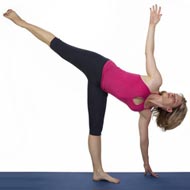- Aromatherapy (36)
- Benefits of Yoga (282)
- Home Remedies (1087)
- massage therapy (9)
- Preventive Therapy (135)
- Running (41)
- Skin Care (15)
- Stress Relief (25)
- Stretching (5)
- walking (33)
- Womens Health (14)
- Yoga Benefits for Pregnant Women (16)
- Yoga Benefits for Students (3)
- Yoga for Children (11)
- Yoga for Holistic Living (37)
- Yoga for Midlife Crisis (3)
- Yoga for Senior Citizens (2)
- Yoga for the Workplace (1)
- Yoga Health Tips (185)
- Yoga Practice during Menstruation (5)
Merits And Demerits Of Iyengar And Flow Yoga

It is not really easy to switch from one to the other, even though not altogether impossible. The reason is that, a student learns Iyengar Yoga through thorough practice of Yogasanas (Yoga postures) and pranayama (breathing exercises). Iyengar Yoga comprises of more than 200 classical yoga poses and 14 breathing exercises with alternatives to many. These range from the easy to the extremely difficult. The poses and breathing exercises are structured and systematized in such a way that students can progress quite smoothly from the basics to the advanced. In the process they improve their strength and flexibility.
Iyengar Yoga concentrates primarily on the right physical alignment that helps the practitioner develop his or her body harmoniously without suffering pain or injury while, or after practicing. But, Iyengar Yoga is also famous for the use of props while doing asanas (poses) and exercises. The props include Yoga blocks and belts, straps, benches, cushions and sand bags that help beginners do the asanas (poses) more easily than they otherwise would without many years of practice. But, the use of props, notwithstanding, Iyengar Yoga is staunchly based on traditional Yoga of the sage Patanjali, except that this school lays greater emphasis on the development of stamina, strength, balance and flexibility.
Flow Yoga on the other hand, is Vinyasa Yoga in which its strength lies in its diversity. Vinyasa means breath-synchronized movement and in this form of Yoga you progress from pose to pose without stopping, but in a flow, harmonious with your breathing pattern. While in Iyengar Yoga and most other styles of Yoga you take a breather between asanas (poses) in Flow Yoga, the flow is almost incessant; non-stop and something akin to Yoga dance. One of the best examples of Flow Yoga is the Surya Namaskar (Sun Salutation exercise) in which the person does a continuous flow of 12 (or sometimes 13 or 14) poses in one smooth cycle. Taking off from here, the Vinyasa school added several more Yogasanas (poses) to continue the flow and this is how Flow Yoga came to be.
Both Iyengar Yoga and Flow Yoga have their own merits and demerits, like everything we do in life. But to answer your question, it is not very easy switching from one to the other. You may not be able to hold a pose for long in Flow Yoga, but that is not what the intention is in Flow Yoga anyway. The practice of Flow Yoga stipulates dynamic movement not static. But you can still derive all the benefits of traditional Yoga while practicing Flow Yoga even without holding any pose for long. The point is that, in Flow Yoga you repeat the cycles over and over again. So you perform the same asana (pose) repeatedly, deriving its benefits. For steadiness and equilibrium there is always the practice of Pranayama (breathing exercises) and meditation.
- RSS Feeds -
- All posts
- All comments
- Getting to Know Iyengar Yoga Every day there are new yoga classes opening in some part of the world. Peopl...
- Yoga To Lose Stomach Fat How To Lose Stomach Fat If you want to lose stomach fat, there are many ways ...
- Iyengar Yoga For You ‘Yoga For You’ is a multimedia CD-Rom conceived and created under...
- Yoga Balance And Healing Arts Balance Healing Arts Center Yoga, Fairbanks, Alaska, was set up with the inte...